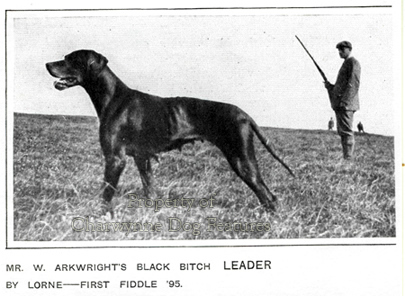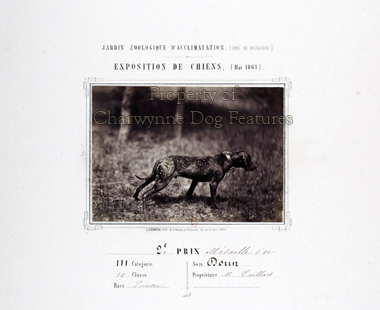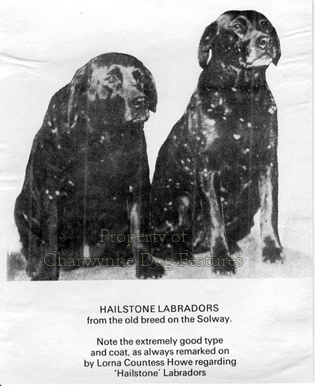915 COATING THE SPORTING DOG
COATING THE SPORTING DOG
by David Hancock



We may have a multitude of sporting breeds of dog to choose from nowadays but sadly largely along lines of 'approved' coat colours. This deprives us not only of variation visually but genetically too. A century ago, black Pointers were favoured, as the great Pointer man Arkwright demonstrated and as the French exemplified in their show rings. It's quite rare to see one nowadays. From time to time 'hailstone' coats cropped up both in Pointer and early Labrador litters. Not any more - or would anyone own up if one did! Yet, the Hailstone Labradors of the Solway were much admired by Lorna, Countess Howe, who knew a bit about the breed. The famous coursing Greyhound Master M'Grath had hailstone markings on head, neck and legs. I have lamented before the substitution of the blonde coat for the red-gold coat in the Golden Retriever. Fanciers of the latter even changed their Breed Standard's wording to accommodate the fading colour in their breed. But the red-gold coat was once preferred because of its weatherproof nature, surely an advantage in a gundog breed. 
In the terrier breeds, solid white is desired in Bull Terriers but frowned on in Fox Terriers. I do see a black and tan Bull Terrier occasionally but never a black and tan Fox Terrier - they have to be mainly white to please most judges. Is that good for the breed? How many outstanding dogs have not been bred from because their coat colour is now 'unfashionable'? How does that better a breed? A white terrier may have been easier to spot in the hunting field, but what kind of sportsman declines to breed from a really impressive sporting dog simply because of the colour of its coat? This is yet another sin of the show ring. For the Fox Terrier white has to predominate. In the Bull Terrier, blues and livers are 'highly undesirable'. I see some quite magnificent blue and some excellent liver-coloured Staffies outside the show rings, but in the show specimens black and tan or liver colour is considered to be 'highly undesirable'. I have seen magnificent Pit Bull Terriers in liver coats, as well as good-looking black and tan 'Irish Staffies'. Is there any hair-colour discrimination in human beauty contests?
A decade or so ago, Bob Truman was winning field trials with a mainly white Gordon Setter. Could such an outstanding working gundog have ever triumphed in the show ring? Are we breeding for excellence, as our ancestors did, or just to please a breed council? This really does matter, if you want the best dogs to be bred from to perpetuate the best genes. Field trial champion Gordon Setter Freebirch Vincent never being able to win at Crufts? But the Kennel Club advertises this show as exhibiting 'the best of the very best'. I don't think so. If you entered a black Airedale Terrier for a KC show, it would be thrown out of the ring for not conforming to the Breed Standard. But solid black is in this breed's gene pool, black Airedales are acknowledged in the United States, with at least one kennel specialising in them. Why reduce the breed's coat colour span and therefore its genetic variety? It's just a show ring fad and certainly not a breed advantage.
William Wordsworth once wrote:
"Their colours and their forms, were then to me
An appetite; a feeling and a love,
That had no need of a remoter charm,"
and those words could be applied to the human attitude towards the coat colour of dogs. So often the colour is the appeal, the dog having 'no need of a remoter charm'. Would not people who choose, red Irish Setters, white Samoyeds, a rich golden-liver Sussex Spaniel or a sedge-coloured Chesapeake Bay retriever quite often have the coat colour as 'an appetite', as Wordsworth put it? Conversely, there is a lack of appetite in far too many breeders for colours that do not match their need.
A century ago, the writer and vet Frank Townend Barton was horrified to discover a white pup in his newly arrived litter of purebred Bloodhounds. The unfortunate pup was quickly consigned to the bucket, an act he later said he regretted. Leading geneticist and GSD expert, the late Dr Malcolm Willis, once wrote: "Colour is of a certain aesthetic and economic value but it has no bearing upon the physical and mental ability of the animal: hence attention to colour, whilst it is necessary, should not become an all-important factor in matings, and the avoidance of a potentially great stud dog on colour grounds is generally unwise. Colour prejudice rules! But when Danish geneticist Ojvind Winge examined the records of the kennel club registrations of that country, half a century ago, he was disappointed to discover that a significant percentage of dogs registered, could not have been born from the parents listed, on colour-inheritance grounds. Coat-colour never lies!